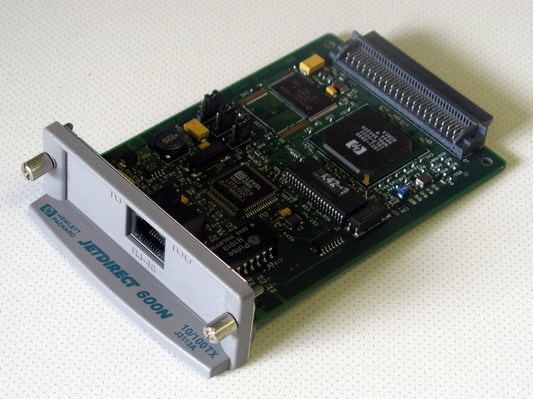 | ||
HP Jetdirect is the name of a technology sold by Hewlett-Packard that allows computer printers to be directly attached to a Local Area Network. The "Jetdirect" designation covers a range of models from the external 1 and 3 port parallel print servers known as the 300x and 500x, to the internal EIO print servers for use with HP printers. The Jetdirect series also includes wireless print server (Bluetooth, 802.11b and g) models, as well as gigabit Ethernet and IPv6-compliant internal cards.
Contents
History
HP Jetdirect was first introduced in March 1991 (code named QuickSilver) with the LaserJet IIIsi network printer (code named Eli). Jetdirect is based on HP's MIO (Modular Input/Output) interface, which was designed from the ground up with the IIIsi to create a mainstream full function high performance networked printer. The initial MIO interface card had Ethernet and Token Ring physical layer variants and used various networking protocols over an AUI/BNC connection. Initially, a printer needed a separate card for each protocol, such as TCP/IP, IPX/SPX, AppleTalk, or DLC/LLC. The following year the team applied the technology to the legacy accessory slot on the LaserJetIIs and IIIs XIO (Extended Input/Output). MIO type Jetdirect cards were also used for network connectivity on some HP/Agilent laboratory equipment such as the 6890A and 6890 Plus series of gas chromatographs. These included unusual network connection types such as HPs I-Net which was used as an interconnect between various pieces of hardware that controlled the 58xx and 68xx series gas chromatographs. Not until 1994 would MIO interface cards be released that could support more than one protocol per card.
The next development releases added connection interfaces. In 1992, a card with both 8P8C modular telephone and BNC connectors for Ethernet was released, and in 1993, the first external Jetdirects were introduced with a parallel interface. This enabled Jetdirect cards to connect to almost any printer, making that printer network-capable. In 1995, the Ex plus 3 was released, with 3 parallel ports on one network interface, allowing 3 printers to share 1 network address.
1997 saw the new numbering format for both internal and external Jetdirect servers. Internals began the 6xx series with the release of the 600n, multi-protocol card that supported TCP/IP, IPX/SPX, DLC/LLC, and AppleTalk over a token-ring network; along with the 1760x series external print server - also multi-protocol. An Ethernet version of the 600n was released in 1998. In 1999, the Jetdirect autoswitch was introduced.
1998 also saw the release of 170x, the first value-line print server aimed at smaller companies that did not necessarily need full networking - only TCP/IP or IPX/SPX support. This was followed in 2000 by the Jetdirect 70x home print server.
MIO
MIO (Modular Input/Output) was the first technology developed by HP for its laser printers to enable the addition of peripheral cards such as Jetdirect.
LIO
LIO (Low-end I/O) interfaces were developed by HP as a corporate response to the strictly internal MIO and EIO development path. The LIO interface differs from MIO/EIO in that the card is wrapped in an external plastic casing and is hot-swappable. The LIO backplane technology is based on a low power/low-voltage (< 1-volt) differential signaling technology.
EIO
EIO (Enhanced Input/Output) is a modular interface developed by HP for its printers to expand their capabilities. EIO does not just serve Jetdirect cards, but EIO hard drives and the EIO Connectivity card for adding communication ports to the printers as well. EIO utilizes the 3.3V signaling technology of the Conventional PCI bus and is significantly more energy-efficient than MIO technology. EIO print servers will not work in LIO slots, nor will the LIO print servers work in EIO slots.
615n series ASIC issue
In 2002 HP released the 615n series of Internal EIO print server. This model featured a new chipset manufactured in Singapore that had a problem related to either overheating or data overload. Otherwise known as the ASIC issue, this meant the 615n card could fail without warning, and when it failed, would completely shut down, appearing to vanish from the printer entirely.
Soon afterwards, HP began to do a per-item replacement policy that has ended as of October 31, 2008, when all known 615n cards were at least 4 years old and at such time HP felt it had taken appropriate corporate responsibility for a defect in manufacturing.
The 615n cards most often affected were the units installed in the Laserjet 2300, 4200 and Color 4600 series. Those cards appear to be most prone to failure.
Any 615n series card can fail, but it is up to HP to determine if the failure is due to the chipset or some other factor. HP recommended to call them or contact them through the Web site and they will proceed to do some simple troubleshooting steps to determine if the failure is due to the chipset or some other cause. If it is proven to be the chipset, HP would be able to replace the card under warranty with an as-new card (nominally a 620n).
bt1300
The BT1300 is a Bluetooth compliant network adapter for network-ready parallel or USB printers. (Discontinued)
Print Server Appliance 4250
The Print Server Appliance 4250 is perhaps the most ambitious of the Jetdirect products - being a complete printing facility in a box. The system comes ready to go with a pre-loaded and configured Print Server running on a Linux core with an Apache Web Server. Once connected to the network, the device is able to manage up to 50 print shares with any supported network-ready printer, not just HP products. (Discontinued)
EIO connectivity card
The Jetdirect EIO connectivity card allows for the expansion of any EIO printer to gain a USB 1.0, Serial, and Localtalk interface. This card has all three interface connectors and on-board electronics to give the printer the ability to use these interfaces. (Discontinued)
